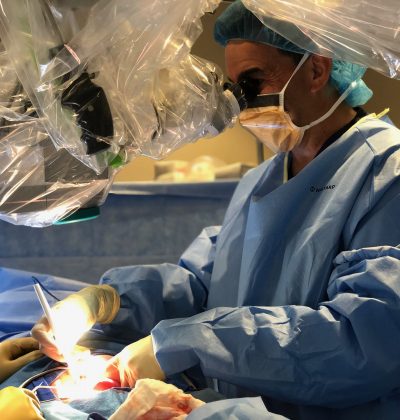Tubal Reversal Surgery
vs
In Vitro Fertilization

Tubal Reversal Surgery
The tubal reversal surgery involves making a incision in the abdomen and reconnecting the Fallopian tubes under a microscope. This surgery requires general anesthesia. The surgery typically lasts from 2.5 hours up to 4 hours. Because of the abdominal incision, recovery from the surgery typically takes 2-3 weeks before most patients resume normal activities, and several months for a full recovery.
In Vitro Fertilization
The IVF process involves approximately 20 days of injectable medications to prepare multiple eggs for collection. The eggs are collected by placing a needle into the ovaries under sedation anesthesia. The eggs are combined with sperm outside of the body. The resulting embryos are grown for 5-6 days and are then frozen. Patients have the option to perform genetic testing on the embryos to select ones that are genetically normal. Embryos are then put back in a procedure known as a frozen embryo transfer.

What You Need To Know
Tubal Reversal Surgery
After a tubal ligation involving cutting, burning, clips, clamps, or rings, patients will have the option to consider a tubal ligation reversal surgery or in vitro fertilization. There are many things that must be considered when selecting between the options for pregnancy after a tubal ligation.
The tubal reversal surgery involves making a incision in the abdomen and reconnecting the Fallopian tubes under a microscope. This surgery requires general anesthesia. The surgery typically lasts from 2.5 hours up to 4 hours. Because of the abdominal incision, recovery from the surgery typically takes 2-3 weeks before most patients resume normal activities, and several months for a full recovery.
Risks involved in the surgery include injury to internal organs such as bowels and bladder. This risk is increased when patients have had multiple abdominal surgeries such as cesarean sections. There are risks that the tubes have become scarred closed after the tubal ligation and cannot be repaired. Scar tissue can form after the surgery to open the tubes and the risk of ectopic pregnancies are higher after tubal reversal surgery. If the partner’s sperm counts are low, the chances for natural pregnancy after a tubal ligation are much lower. Obesity can increase the difficulty and risks of the surgery and influence the overall chance of pregnancy after the procedure.
A woman’s age is one of the most critical factors in the chances of pregnancy by any method. The longer it takes for a pregnancy to occur after a tubal ligation will affect the overall chances pregnancy will occur when women are 35 or older.
The tubal reversal surgery has several advantages over IVF. The tubal reversal surgery is offered at a fixed cost that is usually considerably less that IVF and the necessary medications. Couples can attempt pregnancy naturally after a tubal reversal. If multiple children are desired, no additional treatment is needed in the future. Some patients may also experience a reduction in menstrual pain after a tubal ligation reversal, including women with post tubal ligation pain syndrome.

An Overview
In Vitro
Fertilization
In vitro fertilization, or IVF, can be used as an effective alternative to a tubal ligation surgery.
In Vitro Fertilization has advantages and disadvantages when compared to a tubal ligation reversal. IVF does not require an abdominal incision and avoids the lengthy recover time associated with abdominal surgery.
IVF involves using medications that are injected for approximately 20 days. The amount of eggs a woman can produce will be influenced by multiple factors. On average, 10 to 15 eggs would be considered good. The eggs are then fertilized by placing the sperm in the same dish as the eggs, or by injecting sperm directly into the eggs in a procedure called ICSI. After the eggs are fertilized, they are watched for 5 to 6 days. At this point, cells can be removed from the embryo for genetic testing. This testing can tell if an embryo has the correct number of chromosomes. This testing can also tell us if the embryo is a boy or girl. Embryos are put back in the uterus by a process called a Frozen Embryo Transfer.
The risks of IVF are much lower than the risks of a tubal reversal surgery. The advantages of IVF include:
- No abdominal surgery and no lengthy recovery
- Quicker time to pregnancy
- Save frozen embryos for the future
- Lower risk of ectopic pregnancy
- Can be used with male factor infertility
The biggest disadvantage to IVF is the cost. Compared to a tubal ligation reversal surgery, IVF can cost twice as much, or more.